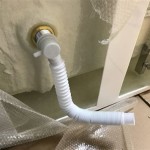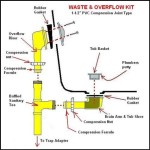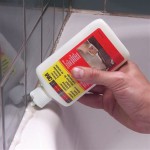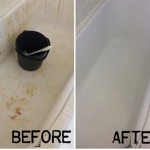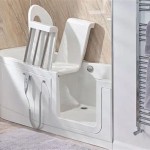How to Unclog Your Bathtub Drain Naturally
A clogged bathtub drain is a common household nuisance that can disrupt daily routines. Commercial drain cleaners often contain harsh chemicals that can damage pipes and pose health risks. Fortunately, several natural and readily available methods can effectively clear a clogged bathtub drain without resorting to potentially harmful substances. This article will explore various natural approaches to unclogging a bathtub drain, emphasizing preventative measures to minimize future occurrences.
Identifying the Cause of the Clog
Before attempting to unclog a bathtub drain, it is crucial to understand the typical causes of these blockages. The most frequent culprits include hair, soap scum, mineral buildup, and small objects inadvertently dropped into the drain. Hair is particularly problematic as it tends to bind with soap scum and other debris, forming a dense mass that restricts water flow. Soap scum, a residue formed from the interaction of soap with hard water minerals, can accumulate along the drain walls, gradually narrowing the passage. Mineral buildup, especially in areas with hard water, contributes to the gradual constriction of the drainpipe. Occasionally, small items such as bottle caps, jewelry, or pieces of toys can also contribute to or initiate blockage.
Understanding the composition of the clog informs the choice of the most appropriate unclogging method. For instance, a clog primarily composed of hair may respond well to mechanical removal, while a soap scum-based clog might benefit from a dissolving agent. Observing the draining rate and the type of debris that comes to the surface can offer clues about the nature of the blockage.
Boiling Water: A Simple First Step
One of the simplest and often effective methods for clearing a minor bathtub drain clog is using boiling water. This approach is most effective for clogs caused by soap scum or grease, as the hot water helps to dissolve these substances. To use this method, first, carefully remove any standing water from the bathtub. Then, boil a kettle or pot of water. Once boiling, slowly pour the water directly down the drain. Exercise caution when pouring boiling water to avoid burns. If the drain does not clear immediately, repeat the process a few times. It is important to note that this method should not be used with PVC pipes, as the high temperature can potentially soften or warp the plastic. For bathtubs with metal pipes, boiling water is generally a safe and effective initial approach.
The effectiveness of boiling water relies on its ability to liquefy fatty substances and dislodge loose debris. The force of the water being poured down the drain also contributes to pushing the clog further down the pipe. However, if the clog is composed primarily of hair or solid objects, boiling water alone is unlikely to be successful and may require alternative methods.
Baking Soda and Vinegar: A Chemical-Free Reaction
A popular and effective natural drain cleaner involves using a combination of baking soda and vinegar. This method relies on a chemical reaction between the two ingredients, which produces carbon dioxide gas. The fizzing action of the gas helps to loosen and dislodge the clog. Begin by removing any standing water from the bathtub. Pour approximately one cup of baking soda down the drain, followed by one cup of white vinegar. The mixture will immediately begin to fizz. Let the mixture sit for at least 30 minutes, or preferably longer, to allow the reaction to fully break down the clog. After the waiting period, flush the drain with hot water. The hot water helps to wash away the loosened debris. If the drain remains clogged, repeat the process. In stubborn cases, letting the baking soda and vinegar mixture sit overnight can increase its effectiveness.
The success of the baking soda and vinegar method depends on the thoroughness of the chemical reaction. Ensuring that the drain is relatively dry before adding the ingredients maximizes the concentration of the reaction. Using white vinegar, as opposed to other types of vinegar, ensures a consistent and predictable chemical reaction. The combination of the effervescent action and the dissolving properties of the vinegar makes this method effective against a wide range of clogs, including those composed of hair, soap scum, and grease.
The Wire Hanger or Plumber's Snake: A Mechanical Approach
For clogs composed primarily of hair or solid objects, a mechanical approach may be necessary. A straightened wire hanger or a plumber's snake (also known as a drain auger) can be used to physically remove the clog. Straighten a wire coat hanger, leaving a small hook at the end. Carefully insert the hooked end of the hanger into the drain opening. Rotate and probe the hanger to snag the clog. Pull out any debris that is retrieved. Repeat this process several times until no more debris is extracted. If using a plumber's snake, follow the manufacturer's instructions for insertion and rotation. The snake is designed to reach further into the drainpipe and to break up or retrieve stubborn clogs. After removing the clog, flush the drain with hot water to ensure that any remaining debris is washed away.
The effectiveness of this method relies on the skill and patience of the user. Care must be taken to avoid pushing the clog further down the drain or damaging the drainpipe. Proper lighting and a clear view of the drain opening are essential for effective removal. For particularly deep or stubborn clogs, a plumber's snake is generally more effective than a wire hanger due to its greater reach and robustness.
Baking Soda and Salt: An Alternative Combination
An alternative to the baking soda and vinegar method involves using a combination of baking soda and salt. This mixture provides a slightly abrasive action that can help to scrub the drain walls and dislodge stubborn debris. Begin by removing any standing water from the bathtub. Pour approximately one-half cup of baking soda down the drain, followed by one-half cup of table salt. Allow the mixture to sit in the drain for several hours, or preferably overnight. After the waiting period, flush the drain with hot water. The hot water helps to dissolve any remaining residue and wash away the loosened debris. This method is particularly effective for clogs caused by soap scum and mineral buildup.
The abrasive action of the salt enhances the effectiveness of the baking soda in breaking down the clog. The extended soaking time allows the mixture to penetrate and loosen the blockage. It is important to use table salt, as opposed to coarser salts, to avoid further clogging the drainpipe. This method is generally considered to be gentler than the baking soda and vinegar approach and may be more suitable for older or more delicate pipes.
Enzyme Drain Cleaners: A Biological Solution
Enzyme drain cleaners offer a biologically based approach to clearing clogged drains. These cleaners contain enzymes that break down organic matter, such as hair, grease, and soap scum. Unlike chemical drain cleaners, enzyme cleaners are non-corrosive and safe for all types of pipes. To use an enzyme drain cleaner, follow the manufacturer's instructions. Typically, this involves pouring the cleaner down the drain and allowing it to sit for a specified period, usually overnight. After the soaking period, flush the drain with warm water. Enzyme cleaners are most effective when used regularly as a preventative measure to prevent the buildup of organic matter in the drainpipe.
The effectiveness of enzyme drain cleaners depends on the concentration of enzymes and the length of the soaking period. These cleaners work gradually, breaking down the organic matter over time. While they may not provide immediate results for severe clogs, they are an environmentally friendly and safe option for maintaining clear drains. Regular use of enzyme drain cleaners can significantly reduce the likelihood of future clogs and minimize the need for more aggressive unclogging methods.
Preventative Measures to Avoid Future Clogs
Preventing bathtub drain clogs is often easier than clearing them. Several simple measures can significantly reduce the frequency of clogs. One of the most effective preventative measures is using a drain strainer or screen to catch hair and other debris before they enter the drainpipe. Regularly cleaning the drain strainer is essential to prevent it from becoming clogged itself. Avoid pouring grease or oil down the drain, as these substances can solidify and contribute to clogs. Flush the drain with hot water after each use to help wash away any loose debris. Periodically, pour a mixture of baking soda and vinegar down the drain as a preventative cleaning measure. By adopting these simple habits, it is possible to maintain a clear and free-flowing bathtub drain and avoid the inconvenience of dealing with frequent clogs.
Implementing a consistent drain maintenance routine is key to long-term clog prevention. Regular inspection of the drain strainer and prompt removal of accumulated debris prevent the gradual buildup that leads to severe blockages. Educating household members about proper drain usage and the avoidance of grease and solid objects further contributes to preventing future clogs. By combining these preventative measures, the need for reactive unclogging methods can be significantly reduced, ensuring a smoothly functioning bathtub drain.

3 Simple Ways To Unclog A Bathtub Drain Naturally Wikihow

3 Simple Ways To Unclog A Bathtub Drain Naturally Wikihow

How To Easily Unclog Bathtub Shower Drain In 5 Minutes Jonny Diy

How To Unclog A Bathtub Drain Eco Friendly

How To Unclog A Bathtub Drain Without Chemicals

3 Simple Ways To Unclog A Bathtub Drain Naturally Wikihow

How To Unclog A Bathtub Drain Without Chemicals

Authentic Merchandise 4 Ways To Clean A Bathtub Drain Wikihow Cleaner

How To Unclog A Bathtub Drain With Standing Water Naturally

3 Simple Ways To Unclog A Bathtub Drain Naturally Wikihow
Related Posts

